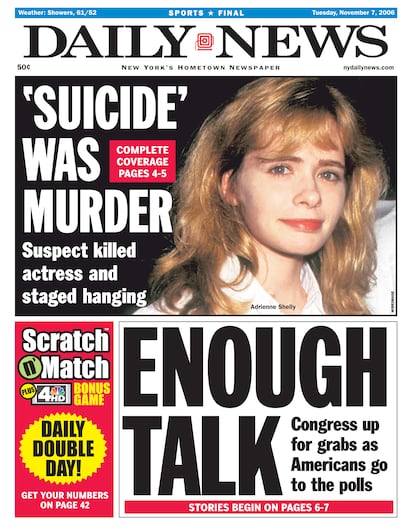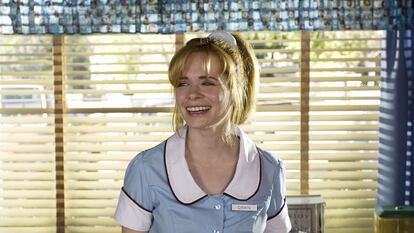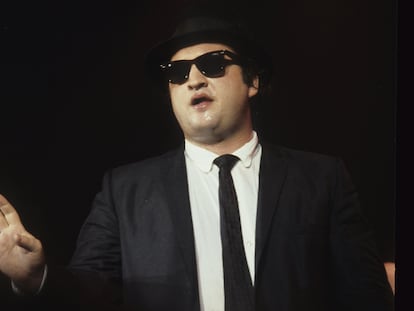The mysterious killing of indie actress Adrienne Shelly: How a suicide turned into a murder
Just as her career was taking off thanks to the movie ‘Waitress,’ the performer and director was found hanging. Now a new documentary is examining who she was and how she really died
On Halloween night in 2006, Adrienne Shelly – one of the most recognizable faces of 1990s independent cinema – was throwing a party for her three-year-old daughter. Shelly was happy and nervous: she was waiting for confirmation that her latest film Waitress, which she wrote, starred in and directed, had been selected for the Sundance Film Festival – an invitation that would take her to the next level as a director.
A few hours after the party, her husband, Andy Ostroy, found her hanging from a sheet in the bathroom of her small office in New York’s West Village, where she would go to work. The media quickly jumped on the news. The New York Post reported: “Indie film star ‘suicide’ stunner – hubby finds gal, 40, hanged in Village apt.” Police also suggested suicide: when Ostroy called them to ask how the investigation was going, he was told that no one was working on the case.
But Ostroy was convinced that Shelly hadn’t taken her life – she had a daughter she loved and was on the brink of fulfilling her dream. “She was the happiest I’d ever seen her,” he says in Adrienne, a new documentary by HBO Max, which he has directed and produced so that no one, least of all their daughter, forgets her. Through a mix of family recordings, interviews with friends like actor Paul Rudd and simple animations, Ostroy provides an intimate portrait of who Adrienne Shelly was, what really happened the day of her death and how the tragedy affected the family. Above all, it is a devastating statement about how life can change in a single moment.
Ostroy’s insistence that Shelly had not taken her life paid off. A few days later, police called him to show him the knot his wife had allegedly made to hang herself. Did she know how to tie a knot like that? Of course not. Nor did he know anybody who had the same Reebok sneakers that left a footprint in the bathroom. A forensic doctor was hired to perform an autopsy, which revealed that Shelly had been strangled. What’s more, she had “fought like a lion” – she hadn’t given up on life.
Shelly always had a clear idea of what she wanted to do in life. She studied acting and producing, then moved to Manhattan to live out her dream of working in show business. She sent her photos off to all the auditions announced in magazines, and one of these photos landed in the hands of director Hal Hartley, who gave her the leading role in his first film, The Unbelievable Truth (1989). Movie critic Roger Ebert described it as a “movie for film buffs,” while the distribution company Miramax, co-founded by convicted sex offender Harvey Weinstein, offered to buy the rights if more nude scenes of Shelly were included. Hartley refused, but the experience had given Shelly a taste of what the film industry expected of her.

Her next film with Hartley, Trust (1990), was also well received by critics. It was tipped as a favorite in the Sundance Film Festival, and received the award for best script. The festival also turned Shelly into a muse of independent cinema. Critic Kent Jones described her as “the first performer in movies to suggest a truly suburban intelligence,” and Screen World included her on its 1990 list of most promising actors, alongside Brad Pitt and Juliette Lewis.
Hollywood wanted her. But what she found there was disappointing. In the 2002 documentary Searching for Debra Winger, which looks at the pressures faced by female actors, Shelly tells director Rosanna Arquette that her agent once told her she had to look “fuckable” in order to land a role. She discovered that actresses in Hollywood were poorly valued, if valued at all, and set out on her own path: making movies. It was a challenge, but the only way to play good characters was for her to write them herself.
Her first films as a director were met with mixed reviews, but Shelly was confident that Waitress would mark her place in the film industry. The movie, which she wrote when she was eight months pregnant, is about a woman who is abused by her husband, and who, after falling pregnant, falls in love with her gynecologist. Actress Keri Russell was picked for the lead, while Shelly played a supporting role. From the first reading, there was a sense that the movie was going to be important.
The invitation from the Sundance Film Festival to showcase Waitress arrived on the same day that the police arrested Shelly’s killer: Diego Pilco, an undocumented 19-year-old Ecuadorian who had been doing construction work in the building. According to his first confession, Shelly had complained about the noise, and fearing that she would call the police and he would be deported, he pushed her and she fell against a table. Believing her to be dead, he tried to cover up the crime as a suicide. This version, however, was debunked at trial. The truth was that he had entered her apartment to steal from her and when she found him rummaging through her bag, he strangled her and hung her in the bathroom.
Pilco confessed it himself to Ostroy in 2019, when the widower visited him in prison “to humanize Adrienne for him, so that rather than have a lasting image in his head of this panicked woman calling out for the police, he sees a mother, a wife, a daughter, a sister. That he understood all the moments in the last 14 years that Adrienne missed, that Sophie missed, that I missed, that everyone missed,” Ostroy explained to The Guardian in December.

When Waitress screened at the Sundance Film Festival, Shelly was not alive to see it. But her family and friends gathered there and turned the event into a loving farewell. Waitress would be Shelly’s most successful film. It made $25 million at the box office, and was even turned into a Broadway musical with an all-female cast.
The shocking news of her death also prompted spontaneous waves of donations, which Ostroy has put towards what Shelly would have wanted. “It became very clear that the mission should be to help people like her – struggling artists, women who didn’t get a fair shake in many ways and needed help,” he told journalist Soraya Roberts. Since then, the Adrienne Shelly Foundation has been giving out grants to female filmmakers. One of these grants was received by Chloé Zhao, who a decade on became the second woman to win an Oscar for Best Director with Nomadland. It is legacy that Adrienne Shelly would be proud of.
Tu suscripción se está usando en otro dispositivo
¿Quieres añadir otro usuario a tu suscripción?
Si continúas leyendo en este dispositivo, no se podrá leer en el otro.
FlechaTu suscripción se está usando en otro dispositivo y solo puedes acceder a EL PAÍS desde un dispositivo a la vez.
Si quieres compartir tu cuenta, cambia tu suscripción a la modalidad Premium, así podrás añadir otro usuario. Cada uno accederá con su propia cuenta de email, lo que os permitirá personalizar vuestra experiencia en EL PAÍS.
¿Tienes una suscripción de empresa? Accede aquí para contratar más cuentas.
En el caso de no saber quién está usando tu cuenta, te recomendamos cambiar tu contraseña aquí.
Si decides continuar compartiendo tu cuenta, este mensaje se mostrará en tu dispositivo y en el de la otra persona que está usando tu cuenta de forma indefinida, afectando a tu experiencia de lectura. Puedes consultar aquí los términos y condiciones de la suscripción digital.
More information
Archived In
Últimas noticias
Most viewed
- Sinaloa Cartel war is taking its toll on Los Chapitos
- Oona Chaplin: ‘I told James Cameron that I was living in a treehouse and starting a permaculture project with a friend’
- Reinhard Genzel, Nobel laureate in physics: ‘One-minute videos will never give you the truth’
- Why the price of coffee has skyrocketed: from Brazilian plantations to specialty coffee houses
- Silver prices are going crazy: This is what’s fueling the rally












































